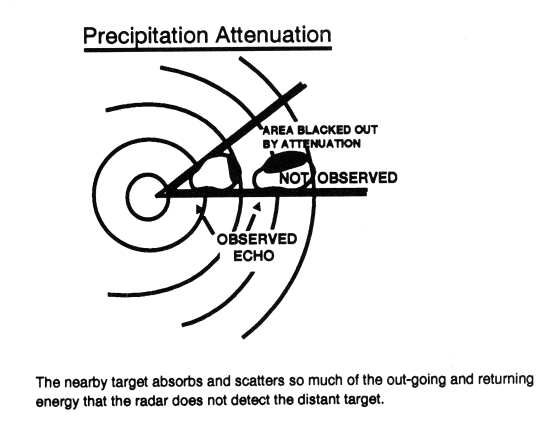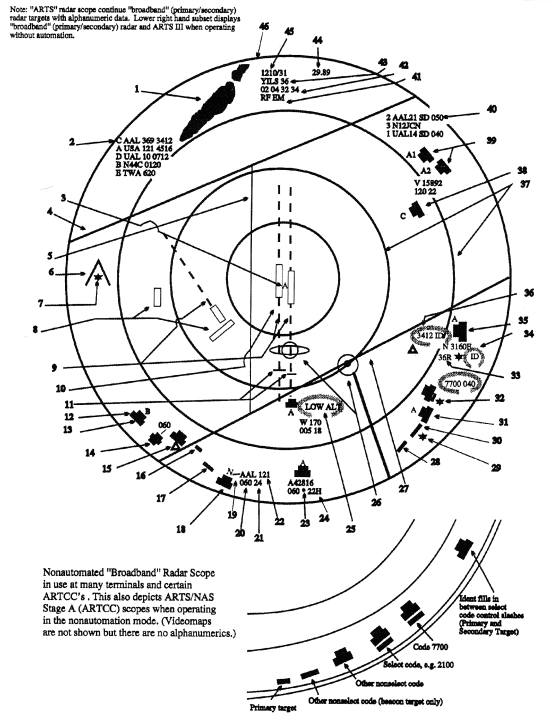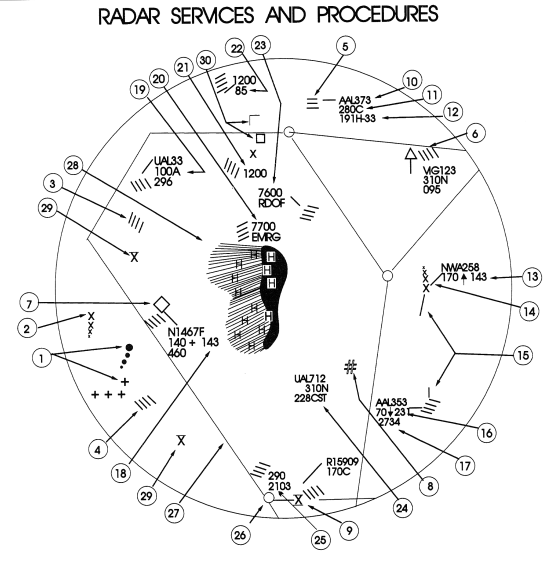|
Page 6 APPENDIX Terms
of Reference:
RADAR DATA PROCESSING Radar data processing provides an automatic display of aircraft identification, altitude, speed, velocity vector (which indicates track direction of the aircraft), and special conditions having to do with the aircraft status; i.e., emergency or radio failure. Also displayed on the radar scopes are weather returns, high terrain, and a feature called Conflict Alert. Conflict Alert consists of the detection of impending infractions of safe separation limits between aircraft and will alert the controller to a potential violation. Another safety feature is the En Route Minimum Safe Altitude Warning (EMSAW). It is incorporated into the Center's computer system and alerts the controller to the potential intrusion of an aircraft into airspace that has terrain at or near its altitude. All incoming data from the radar antennas to the computer system are recorded on magnetic tapes and can be saved indefinitely for future analysis. Having this recall feature has also greatly assisted in the search for aircraft that have become lost or overdue. Occasionally, we are called upon by the Air Force Rescue Coordination Center in Illinois to assist in its search. By "replaying" these tapes, the computer will print on a high speed printer a graphic plot of an aircraft's flight path as flown through the Center's area. We then relay these positions to the Search and Rescue Center (SAR), who, in turn, initiates its search with this data. This program has been a major breakthrough in search and rescue planning and execution and has saved thousands of man-hours and dollars, plus many lives, as SAR forces are able to concentrate its efforts in the vicinity of the last known radar position. FAA Radar Analysis History The FAA has been actively involved with Radar Analysis since the advent of radars into the commercial aviation environment. Over the decades, several software applications have been developed to assist technicians and specialists in analyzing radar systems to ensure safe operation of private and commercial aviation. Developers from outside resources and agencies such as the United States Air Force and its 84th RADES Evaluation Squadron, along with numerous universities and individuals within the FAA community have designed and developed numerous radar analysis programs. The first radar analysis programs came into being in the late 1960s and early 1970s to accommodate the integration and optimization of the Common Digitizer (Model 1) or CD-1s. The only available computing power was at the ARTCCs. In 1994, the National Communications System's Engineering Division and its associated Radar Branch, AOS-520,decided to undertake the tremendous task of standardizing radar analysis software as well as developing a user-friendly suite of radar analysis tools. The Radar Intelligent Tool (RIT) project provides a much needed focal point. Ultimately, it will be the only sanctioned radar analysis tool delivered by the FAA. It provides configuration management, baseline control, quality assurance for the delivered products, a common set of development tools, a standard design approach, a standard design structure, a standard programming language, and standard operating system or environment. Radar Services and Procedures 1-2-1. Radar a.
Capabilities 1. Radar
is a method whereby radio waves are transmitted into the air and are then
received when they have been reflected by an object in the path of the beam.
Range is determined by measuring the time it takes (at the speed of light) for
the radio wave to go out to the object and then return to the receiving antenna.
The direction of a detected object from a radar site is determined by the
position of the rotating antenna when the reflected portion of the radio wave is
received. 2. More
reliable maintenance and improved equipment have reduced radar system failures
to a negligible factor. Most facilities actually have some components
duplicated, one operating and another which immediately takes over when a
malfunction occurs to the primary component. b.
Limitations 1. It
is very important for the aviation community to recognize the fact that there
are limitations to radar service and that ATC controllers may not always be able
to issue traffic advisories concerning aircraft which are not under ATC control
and cannot be seen on radar. (See FIG 1-2-1.) (a)
The characteristics of radio waves are such that they normally travel in a
continuous straight line unless they are: (1)
"Bent" by abnormal atmospheric phenomena such as temperature
inversions; (2)
Reflected or attenuated by dense objects such as heavy clouds, precipitation,
ground obstacles, mountains, etc.; or (3)
Screened by high terrain features. (b)
The bending of radar pulses, often called anomalous propagation or ducting, may
cause many extraneous blips to appear on the radar operator's display if the
beam has been bent toward the ground or may decrease the detection range if the
wave is bent upward. It is difficult to solve the effects of anomalous
propagation, but using beacon radar and electronically eliminating stationary
and slow moving targets by a method called moving target indicator (MTI) usually
negate the problem. FIG
1-2-1 (c)
Radar energy that strikes dense objects will be reflected and displayed on the
operator's scope thereby blocking out aircraft at the same range and greatly
weakening or completely eliminating the display of targets at a greater range.
Again, radar beacon and MTI are very effectively used to combat ground clutter
and weather phenomena, and a method of circularly polarizing the radar beam will
eliminate some weather returns. A negative characteristic of MTI is that an
aircraft flying a speed that coincides with the canceling signal of the MTI
(tangential or "blind" speed) may not be displayed to the radar
controller. (d)
Relatively low altitude aircraft will not be seen if they are screened by
mountains or are below the radar beam due to earth curvature. The only solution
to screening is the installation of strategically placed multiple radars which
has been done in some areas. (e)
There are several other factors which affect radar control. The amount of
reflective surface of an aircraft will determine the size of the radar return.
Therefore, a small light airplane or a sleek jet fighter will be more difficult
to see on radar than a large commercial jet or military bomber. Here again, the
use of radar beacon is invaluable if the aircraft is equipped with an airborne
transponder. All ARTCCs' radars in the conterminous U.S. and many airport
surveillance radars have the capability to interrogate MODE C and display
altitude information to the controller from appropriately equipped aircraft.
However, there are a number of airport surveillance radars that don't have Mode
C display capability and; therefore, altitude information must be obtained from
the pilot. (f)
At some locations within the ATC en route environment, secondary-radar-only (no
primary radar) gap filler radar systems are used to give lower altitude radar
coverage between two larger radar systems, each of which provides both primary
and secondary radar coverage. In those geographical areas served by
secondary-radar only, aircraft without transponders cannot be provided with
radar service. Additionally, transponder equipped aircraft cannot be provided
with radar advisories concerning primary targets and weather. REFERENCE- (g)
The controller's ability to advise a pilot flying on instruments or in visual
conditions of the aircraft's proximity to another aircraft will be limited if
the unknown aircraft is not observed on radar, if no flight plan information is
available, or if the volume of traffic and workload prevent issuing traffic
information. The controller's first priority is given to establishing vertical,
lateral, or longitudinal separation between aircraft flying IFR under the
control of ATC. c.
FAA radar units operate continuously
at the locations shown in the Airport/Facility Directory, and their services are
available to all pilots, both civil and military. Contact the associated FAA
control tower or ARTCC on any frequency guarded for initial instructions, or in
an emergency, any FAA facility for information on the nearest radar service. 1-2-2. Air Traffic Control Radar Beacon System (ATCRBS) a.
The ATCRBS, sometimes referred to as
secondary surveillance radar, consists of three main components: 1.
Interrogator. Primary radar relies on
a signal being transmitted from the radar antenna site and for this signal to be
reflected or "bounced back" from an object (such as an aircraft). This
reflected signal is then displayed as a "target" on the controller's
radarscope. In the ATCRBS, the Interrogator, a ground based radar beacon
transmitter-receiver, scans in synchronism with the primary radar and transmits
discrete radio signals which repetitiously request all transponders, on the mode
being used, to reply. The replies received are then mixed with the primary
returns and both are displayed on the same radarscope. 2.
Transponder. This airborne radar
beacon transmitter-receiver automatically receives the signals from the
interrogator and selectively replies with a specific pulse group (code) only to
those interrogations being received on the mode to which it is set. These
replies are independent of, and much stronger than a primary radar return. 3.
Radarscope. The radarscope used by the
controller displays returns from both the primary radar system and the ATCRBS.
These returns, called targets, are what the controller refers to in the control
and separation of traffic. b.
The job of identifying and maintaining
identification of primary radar targets is a long and tedious task for the
controller. Some of the advantages of ATCRBS over primary radar are: 1. Reinforcement
of radar targets. 2. Rapid
target identification. 3. Unique
display of selected codes. c.
A part of the ATCRBS ground equipment
is the decoder. This equipment enables a controller to assign discrete
transponder codes to each aircraft under his/her control. Normally only one code
will be assigned for the entire flight. Assignments are made by the ARTCC
computer on the basis of the National Beacon Code Allocation Plan. The equipment
is also designed to receive MODE C altitude information from the aircraft. NOTE- d.
It should be emphasized that aircraft
transponders greatly improve the effectiveness of radar systems. REFERENCE- 1-2-3. Surveillance Radar a.
Surveillance radars are divided into
two general categories: Airport Surveillance Radar (ASR) and Air Route
Surveillance Radar (ARSR). 1. ASR
is designed to provide relatively short- range coverage in the general vicinity
of an airport and to serve as an expeditious means of handling terminal area
traffic through observation of precise aircraft locations on a radarscope. The
ASR can also be used as an instrument approach aid. 2. ARSR
is a long-range radar system designed primarily to provide a display of aircraft
locations over large areas. 3. Center
Radar Automated Radar Terminal Systems (ARTS) Processing (CENRAP) was developed
to provide an alternative to a nonradar environment at terminal facilities
should an ASR fail or malfunction. CENRAP sends aircraft radar beacon target
information to the ASR terminal facility equipped with ARTS. Procedures used for
the separation of aircraft may increase under certain conditions when a facility
is utilizing CENRAP because radar target information updates at a slower rate
than the normal ASR radar. Radar services for VFR aircraft are also limited
during CENRAP operations because of the additional workload required to provide
services to IFR aircraft. b.
Surveillance radars scan through 360
degrees of azimuth and present target information on a radar display located in
a tower or center. This information is used independently or in conjunction with
other navigational aids in the control of air traffic. 1-2-4. Precision Approach Radar (PAR) a.
PAR is designed to be used as a
landing aid, rather than an aid for sequencing and spacing aircraft. PAR
equipment may be used as a primary landing aid, or it may be used to monitor
other types of approaches. It is designed to display range, azimuth and
elevation information. b.
Two antennas are used in the PAR
array, one scanning a vertical plane, and the other scanning horizontally. Since
the range is limited to 10 miles, azimuth to 20 degrees, and elevation to 7
degrees, only the final approach area is covered. Each scope is divided into two
parts. The upper half presents altitude and distance information, and the lower
half presents azimuth and distance. FIG
1-2-2 NOTE- EXAMPLE-
FIG
1-2-3 EXAMPLE- Target symbols:
Page 6 Copyrightę2002 Ralph Yost, All Rights Reserved. |
||||||||||||||||||||||||||||||||||||||||||||||||||||||||||||||||||||||||||||||||||||||||||||||||||||||||||||||||||||||||||||||||||||||||||||||||||||||||||||||||||||||||||||||||||||||||||||||||||||||||||||||||||||||||||||||||||||||||||||||||||||||||||||||||||||||||||||||||||||||||||||||||||||||||||||||||||||||||||||||||||||||||||||||||||||||||||||||||||||||||||||||||||||||||||||||||||||||||||||||||||||||||||||||||||||||||||||||||||||||||||||||||||||||||||||||||||||||||||||||||||||||||||||||||||


